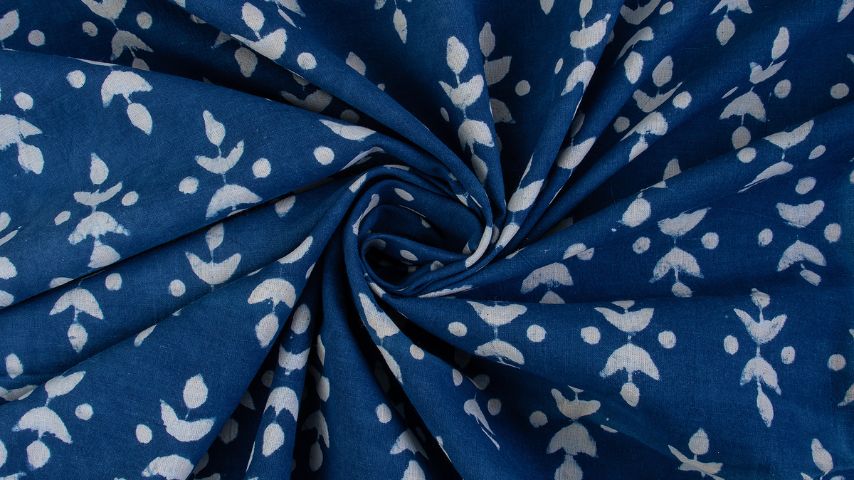The Legacy of Indigo Dyeing
Indigo fabric carries a deep cultural and historical significance. This naturally dyed textile has roots that stretch across continents, from the ancient civilisations of India and Egypt to the vibrant cultures of West Africa and Japan. Indigo dye is derived from the Indigofera plant, a genus that thrives in tropical and subtropical climates. What makes indigo special is not just its brilliant, rich blue hue but also its resistance to fading and its symbolic connection to identity, spirituality, and craft.
In traditional societies, indigo dyeing was a sacred process, often performed by skilled artisans with secrets passed down through generations. Today, this art is preserved in handmade textiles that reflect both cultural heritage and sustainable craftsmanship.
The Indigo Dyeing Process: From Plant to Pattern
Creating indigo fabric is a meticulous and time-honoured process. The dye itself doesn’t bond with fiber in the way that other natural dyes do. It requires fermentation, oxidation, and multiple dips to achieve its signature blue. Here is a breakdown of the steps:
- Harvesting Indigofera Plants – The leaves are soaked and fermented to extract indican, the color-producing compound.
- Prepping the Vat – The dye is transformed into a soluble form in a reducing vat.
- Dyeing the Fabric – Fabric is dipped and then exposed to air, allowing oxidation to turn the yellow-green liquid into brilliant blue.
- Repeating for Depth – Multiple dips deepen the shade and improve colorfastness.
The natural irregularities in hand-dyed indigo fabric give it character, making each piece a one-of-a-kind treasure.
Types of Indigo Fabrics Around the World
Indigo has been embraced globally, resulting in unique interpretations of the textile. Some of the most iconic include:
1. Indian Indigo (Dabu and Bagru Prints)
In Rajasthan, dabu printing and bagru block printing techniques are used on indigo-dyed cotton to create intricate, earthy patterns. These techniques rely on mud resist and hand-carved wooden blocks.
2. Japanese Indigo (Aizome)
Japan’s indigo-dyed textiles, especially shibori and kasuri, emphasize minimalism and subtle texture. These fabrics often serve traditional purposes like kimono and noren (door curtains), but they’re also celebrated in modern fashion.
3. African Indigo (Malian Bogolan and Nigerian Adire)
In West Africa, particularly Mali and Nigeria, indigo fabrics are a symbol of status and spirituality. Techniques like tie-dye (adire) and mud cloth (bogolanfini) result in dramatic geometric designs with cultural symbolism.
Why Indigo Fabric Remains in Demand Today
1. Eco-Friendly and Sustainable
Natural indigo dye is biodegradable and less harmful than synthetic dyes. As the world shifts toward sustainable fashion, indigo fabric is increasingly favored by eco-conscious designers and consumers.
2. Timeless Aesthetic
The classic indigo blue hue is effortlessly elegant, adaptable to modern and traditional interiors and wardrobes alike. It pairs beautifully with whites, neutrals, and earth tones.
3. Durability and Versatility
Indigo-dyed textiles tend to be highly colorfast and resistant to wear, making them ideal for use in home décor, apparel, and accessories.
4. Symbolism and Storytelling
Each indigo fabric is a canvas of cultural expression. The designs, motifs, and dyeing styles often represent ancestral stories, status, and rituals.
Uses of Indigo Fabric in Modern Design
1. Fashion
Indigo is a staple in modern fashion, from denim jeans to luxury shawls, scarves, skirts, and tunics. Designers use it to craft everything from minimalist everyday wear to elaborate, couture garments.
2. Home Décor
Indigo textiles are perfect for accentuating interiors. They’re used for:
- Throw pillows
- Curtains
- Table runners
- Upholstery
- Wall hangings
They add texture, color, and a handcrafted narrative to living spaces.
3. Accessories
Handbags, shoes, and hats made with indigo fabric are statement pieces that blend tradition with modern design sensibilities.
Caring for Indigo Fabric
Proper maintenance ensures longevity without compromising the color or texture. Here’s how to care for your indigo textiles:
- Wash Separately – Indigo can bleed slightly in the first few washes.
- Cold Water Wash – Use mild detergent in cold water to retain color.
- Air Dry – Avoid tumble drying to prevent shrinking or damage.
- Avoid Prolonged Sun Exposure – UV rays may fade the vibrant blue over time.
Following these guidelines will preserve the depth and richness of your fabric for years.
Spotting Authentic Indigo Fabric
To identify genuine indigo-dyed textiles, consider the following:
- Smell – Natural indigo has a distinctive earthy aroma.
- Color Variation – Hand-dyed indigo often shows subtle inconsistencies, which add to its charm.
- Hand Feel – The texture should feel organic and soft, not overly smooth or synthetic.
- Artisan Markings – Many pieces carry the mark or story of the artisan who made them.
Authentic indigo fabric is not just a product; it’s a work of art and history.
Where to Buy High-Quality Indigo Fabric
You can find authentic indigo textiles at:
- Ethical fashion brands
- Handicraft boutiques
- Online marketplaces like Etsy, NOVICA, or local artisan platforms
- Specialty fabric stores
- Cultural fairs and trade shows
Look for certifications or guarantees of natural dye use, fair trade, and handcrafted production.
Conclusion: Indigo Fabric—A Heritage Woven in Blue
Indigo fabric continues to be celebrated for its rich history, deep symbolism, and versatile beauty. It transcends trends, remaining relevant across generations and geographies. As advocates of sustainable living and timeless design, we believe that incorporating indigo into your wardrobe or home décor is more than a style choice—it is a commitment to cultural appreciation and artisanal excellence.









